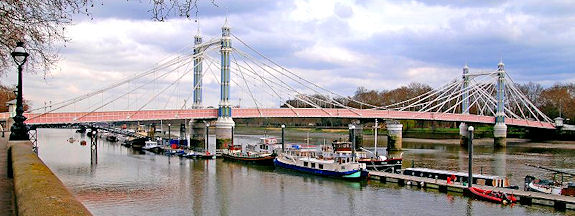
One of only two bridges in London that have never been replaced
Albert Bridge Road, London SW11 4PL
Albert Bridge is a road bridge over the River Thames in West London, connecting Chelsea on the north bank to Battersea on the south bank. Designed and built by Rowland Mason Ordish in 1873 as an Ordish-Lefeuvre Principle modified cable-stayed bridge, it proved to be structurally unsound, and so between 1884 and 1887 Sir Joseph Bazalgette incorporated some of the design elements of a suspension bridge.
The Greater London Council carried out further strengthening work in 1973 by adding two concrete piers, which transformed the central span into a simple beam bridge. As a result of these modifications the bridge today is an unusual hybrid of three different design styles.
Built as a toll bridge, it was commercially unsuccessful; six years after its opening it was taken into public ownership and the tolls were lifted. The tollbooths remained in place however, and are the only surviving examples of bridge tollbooths in London. Nicknamed "The Trembling Lady" because of its tendency to vibrate when large numbers of people walked over it, signs at the entrances warn troops from the nearby Chelsea Barracks to break step while crossing the bridge.
Incorporating a roadway only 8.2 m (27 ft) wide, and with serious structural weaknesses, the bridge was ill-equipped to cope with the advent of the motor vehicle during the 20th century. Despite the many calls for its demolition or pedestrianisation Albert Bridge has remained open to vehicles throughout its existence, other than for brief spells during repairs, and is one of only two Thames road bridges in central London never to have been replaced.
The strengthening work carried out by Bazalgette and the Greater London Council was unable to prevent further deterioration of the bridge's structure. A series of increasingly strict traffic control measures have been introduced to limit its use and thus prolong its life, making it the least busy Thames road bridge in London except for the little-used Southwark Bridge. The bridge's condition is continuing to degrade however, as the result of traffic load and severe rotting of the timber deck structure caused by the urine of the many dogs using it as a route to nearby Battersea Park.
In 1992 Albert Bridge was rewired and painted in an unusual colour scheme designed to make it more conspicuous in poor visibility, and hence avoid being damaged by collisions with shipping. At night it is illuminated by 4,000 bulbs, making it one of West London's most striking landmarks. It is Listed Grade II*.
By road: On A3031, Albert Bridge Road, linking Chelsea and Battersea

Burr, William Hubert, A Course on the Stresses in Bridge and Roof Trusses, Arched Ribs and Suspension Bridges (1886), Kessinger Publishing, ISBN-10: 1104171740 (2009)
Drewry, C.S., A Memoir of Suspension Bridges: Comprising a History of their Origin, BiblioBazaar, ISBN -10 05547 25657 (2008)
Melan, Josef, Theory of Arches and Suspension Bridges (1913, Kessinger Publishing, ISBN-10: 1437437125 (2008)
Minchinton, W., A Guide to Industrial Archaeology sites in Britain, Granada ASIN: B0020ZCPRY (1984)
Peters, Tom, Transitions in Engineering: Guillaume Henri Dufour and the Early 19th Century Cable Suspension Bridges, Birkhauser, ISBN-10: 3764319291 (1987)
Steinman, David, A Practical Treatise on Suspension Bridges: Their Design, Construction and Erection (1922), Kessinger Publishing, ISBN-10: 1436606446 (2008)
Steinman, David, Suspension Bridges and Cantilevers, BiblioBazaar, ISBN-10: 0559673132 (2008)